The ASRock X299E-ITX/ac Motherboard Review: An 18-core No-Compromise Mini-ITX
by Joe Shields on December 4, 2017 8:00 AM ESTVisual Inspection
The socket, the four SO-DIMM slots, and the PCIe slot dominate the face of the black, 10 layer board. Sticking up from the board are the two daughter boards for M.2 as well as the SATA and USB connections. The brushed aluminium chipset heatsink with the ASRock name sits below the back panel IO next to a reset CMOS switch.
The board is busy, and it has to be with the connectivity it brings to the tabl,e and its size. Mini-ITX boards are a tough component to be pleasing to the eye - due to the small size it becomes more difficult to add aesthetic touches and it is more worthwhile to have more functionality instead. To that end, the ASRock X299E-ITX/ac goes without any shrouding over the back panel IO and also does not have any RGB LEDs. There is a single RGB LED header located on the top right-hand corner above the 8-pin EPS 12V connector.
Starting off with fan headers we will find a total of three on the board, which is usual for high-end mini-ITX boards. The first, a 4-pin chassis/pump fan, is located in the upper left-hand corner above the Wi-Fi module and to the left of the VROC header. The other two 4-pin headers, for a CPU and CPU water pump, are located just above the 24-pin ATX 12V connector on the right side. These two are able to auto sense DC or PWM and adjust the control method depending on which type of fan is on the header. The CPU fan connector supports up to 1A/12W and the CPU OPT/W PUMP header is able to output 1.5A(18W).
Audio duties are handled by the latest 7.1 CH Realtek ALC1220 codec supporting Purity Sound 4 and DTS connect. EMI protection and board separation are not found on the board, however it does use Nichicon premium audio caps.
We took off the daughterboards and heatsinks to expose the 7-phase VRM. The X299E-ITX/ac uses 60A Intersil DRMos MOSFETs, premium 60A Power Chokes, and an Intersil ISL69138 7-phase PWM controller (one for the CPU, the other for memory). The 12K caps found on the Taichi and Gaming i9 are also used in this setup. The heatsink is small covered, and was warm while running. I wouldn't recommend overclocking heavily without good airflow, or I would suggest spot cooling if really pushing things.
Looking at a top-down view of the right side, we can see the 24-pin ATX connector on the left, then on the riser card is a USB 3.0 header, six SATA ports, and a USB 2.0 header. To the right of it is the 8-pin EPS 12V plug, front panel header and RGB LED header.
The primary M.2 slot is provided by a riser card plugged into a fifth 'SO-DIMM-like' slot, similar to how ASUS uses a DDR4 slot for its M.2 riser card. The riser card has a single M.2 slot which supports both SATA and PCIe 3.0 modules up to 80mm in length. The other two slots are located on the back of the motherboard supporting only 80mm length and PCIe 3.0 x4 only modules.
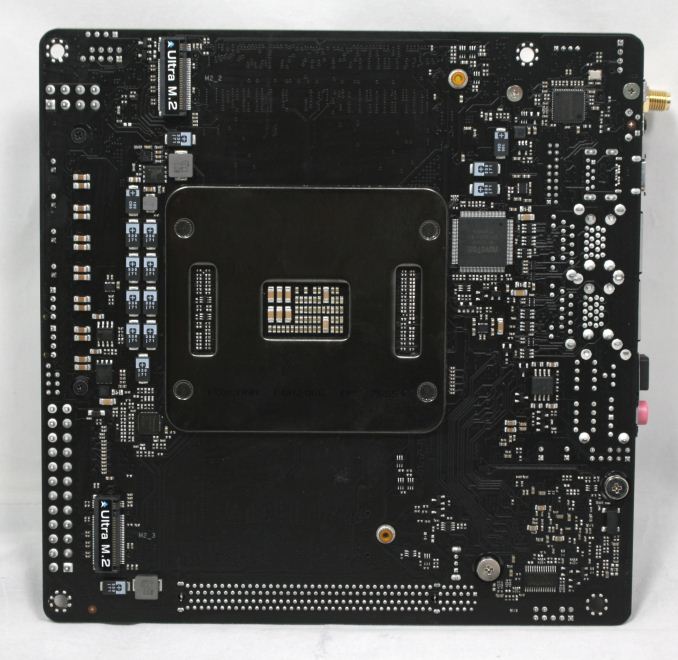
Spot the dual M.2 slots that say 'Ultra M.2'
The back M.2 slots are where VROC is supported.
The next image is the riser card holding the SATA ports as well as the USB 3.0 header and USB 2.0 header. This unit is mounted to the VRM heatsink via screws and plugs into the motherboard just below and to the right of the socket.
The back panel IO shows the Intel Wi-Fi module, a CMOS reset button, the USB 3.1 (10 Gbps) ports in lighter blue, four USB 3.0 ports and the two Intel NICs along with the gold-plated 5 plug audio stack with SPDIF. Not a lot of USB back here, but it is to be expected on such a small board. Normally on a board this size we might see a 3-port audio solution to save space, but ASRock has given it the full stack.
In The Box
We get the following:
- Quick Installation Guide, Support CD, I/O Shield
- 4 x SATA Data Cables
- 1 x ASRock WiFi 2.4/5 GHz Antenna
- 3 x Screws for Ultra M.2 Sockets
The included accessories are fairly sparse, however, it is enough to get running out of the box. Instructions, drivers, SATA cables, the I/O Plate, and Antenna are included.



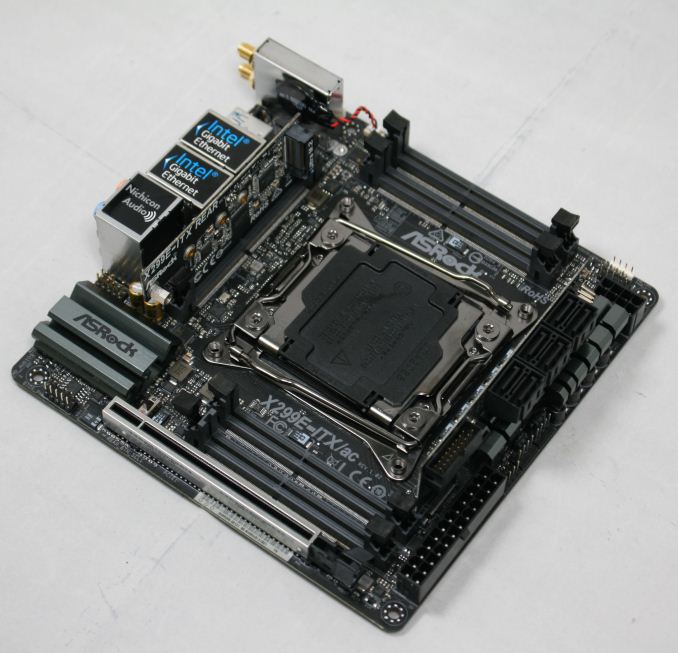
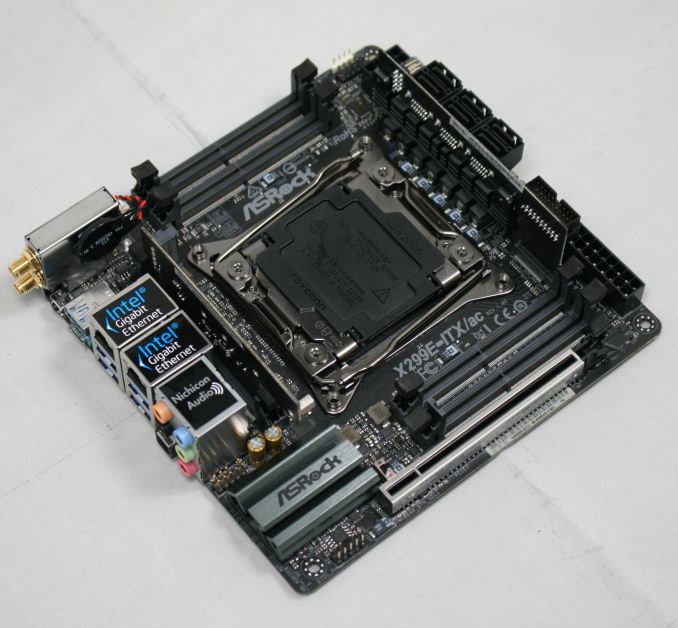


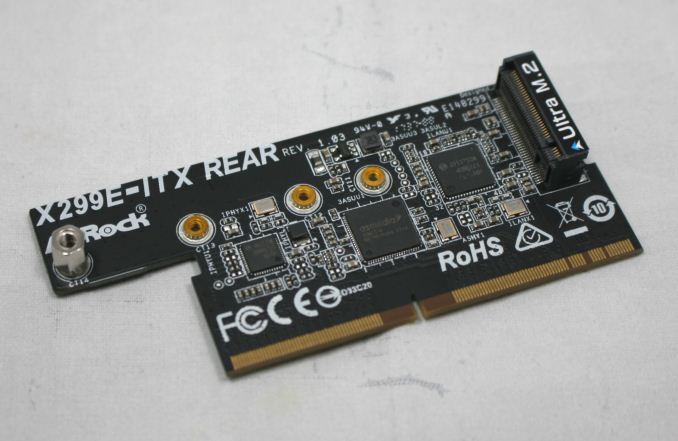
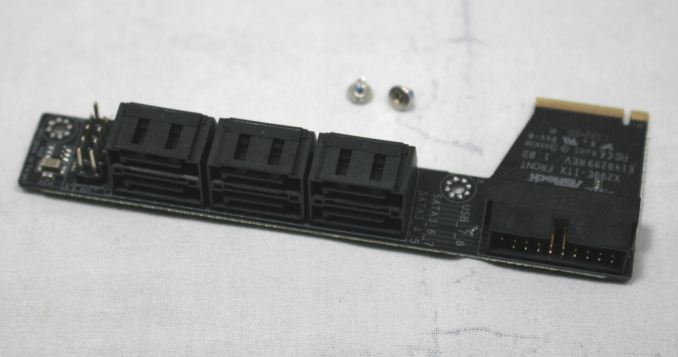
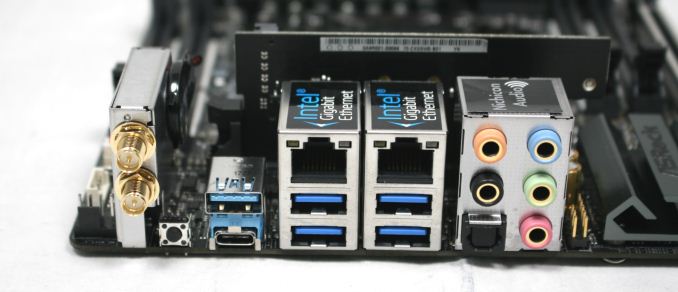















24 Comments
View All Comments
CheapSushi - Monday, December 4, 2017 - link
If you're going to spend the money on this, why would you complain about not being able to use full DIMM just to save money? That's some odd penny pinching. And with your idea, you'd be compromising features just because of that, thus diluting the value of this. Are you planning to spend $$ ONLY to use it for less than a year or something? I don't see the issue. In fact more boards should embrace SODIMMs instead. Full DIMMs are a complete waste on consumer/gaming boards, especially mITX and mATX; much of the PCB is WASTED because of the lack of server features (ECC, buffering, extra voltage ICs, etc); this is often artificially segmented anyway.CheapSushi - Monday, December 4, 2017 - link
I really wish SODIMMs would become the norm on mITX mATX and even ATX for consumer/gamer boards. The DIMM PCB (thus size) is wasted when non-ECC/Buffered.CharonPDX - Tuesday, December 5, 2017 - link
Sheesh! I just want a Micro ATX Coffee Lake board with Thunderbolt 3 and WiFi built in for not a ridiculous amount of money.Rene23 - Saturday, December 9, 2017 - link
I need such a #mini-itx board for AM4 though, ... :-/